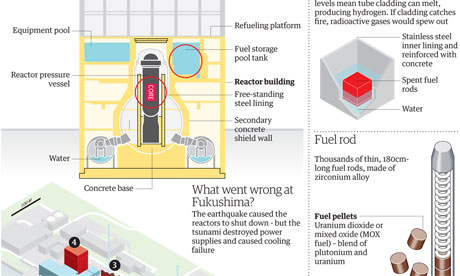Hello! Here we go again, even concrete
will not help stop the
leak of highly radioactive water from the plant!
Fukushima nuclear
power plant update:
get all the data
Japan is racing to gain control of the crisis at the Fukushima nuclear power plan. Where does the most detailed data come from? Updated daily
• Get the data


The 9.0 magnitude earthquake and following tsunami on March 11 has seen a rush by officials to gain control of power plants in the north-east of the country.
The latest is that radioactive water from the plant is leaking into the sea. The 20cm (8in) crack in a containment pit under reactor two may be the source of recent radiation in coastal waters, Tokyo Electric Power (Tepco) officials said.
It was announced earlier this week by Japanese officials that the battle to save reactors 1- 4 has been lost at the Fukushima Daiichi nuclear powerplant. Justin McCurry writes:
The plant's operator, Tokyo Electric Power (Tepco), said the reactors would be scrapped, and warned the operation to contain the nuclear crisis, well into its third week, could last months.
Fukushima nuclear power plant has been closely scrutinised as reports flow in on the progress of the situation - Japan's nuclear board raised the nuclear alert level from four to five and the JAIF warned last week ofproducts such as dairy and spinach being restricted for shipping. Explosions and reports of nuclear fuel rods melting at the power plant have meant progress on the situation has been closely followed as has the environmental effects with concerns for marine life and spreadingradiation through seawater.
Industry body the Japan Atomic Industrial Forum are currently publishing daily updates of the status of power plants in Fukushima which give great detail into the condition of each reactor. Ranked from a level of low to severe, the update records the conditions of core and fuel integrity, water level and containment amongst other key information. These are some of the most in-depth and recent records and show how the crisis is being handled.
Last Friday's report detailed the dangers of radiation to workers, stating that two workers were hospitalised on March 24th 'because of the possible high exposure dose of their foot skin' - yesterday's report stated that the workers had been discharged from hospital. However thedangers facing those working at the plant continues to be a subject of concern as does radiation seeping into drinking water, after twice the safe level of radioactive iodine for young children, was found in Tokyo tap water last week.
The table below shows the status of the reactors in the Fukushima Daiichi (the largest of the Fukushima power plants) and is colour coded to show the severity. Green for low, yellow represents high and red shows those of severe significance as judged by the JAIF. We have usedJAIF's update 54 as of 16:00 local time as this is the most up to the minute data we can get.
A table of major incidents and accidents at the plants can be found in our spreadsheet as can the data for Daini, Onagawa and Tokai Daini Nuclear power stations. What can you do with this data?





